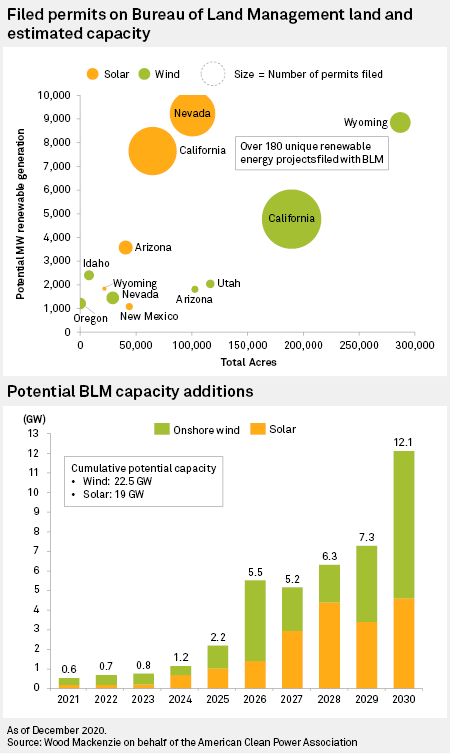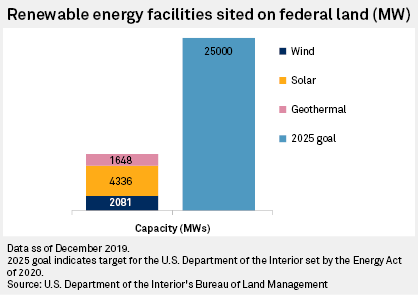S&P Global Offerings
Featured Topics
Featured Products
Events
S&P Global Offerings
Featured Topics
Featured Products
Events
S&P Global Offerings
Featured Topics
Featured Products
Events
Banking & Capital Markets
Economy & Finance
Energy Transition & Sustainability
Technology & Innovation
Podcasts & Newsletters
Banking & Capital Markets
Economy & Finance
Energy Transition & Sustainability
Technology & Innovation
Podcasts & Newsletters
S&P Global Offerings
Featured Topics
Featured Products
Events
18 Jan, 2021
By Zack Hale and Molly Christian
|
A solar farm in Nevada is seen from above. |
A recently enacted U.S. energy innovation package has set a bold new goal for the U.S. Interior Department: the siting and permitting of 25 GW of renewable energy projects on federal lands by 2025.
Reaching that target would mean more than tripling the slightly more than 8 GW of total renewable generating capacity approved since 1978 by the Bureau of Land Management, an agency within the Interior Department.
Industry experts say the aspirational goal is possible, but it will require revamped environmental permitting processes and a major buildout of electric transmission capacity. The challenge could serve as a key test for President-elect Joe Biden's administration as he seeks to implement a $2 trillion climate and energy plan that aims to completely decarbonize the nation's electric grid by 2035.
New coordination office
Interior's 25 GW goal was set by the massive federal spending and coronavirus relief bill signed into law in December 2020. The legislation requires the agency to establish a national Renewable Energy Coordination Office responsible for expediting permitting on federal land.
"Agencies, and especially the BLM, are always struggling with inadequate funding and inadequate staffing," said Alex Daue, assistant director of The Wilderness Society's energy and climate program. Daue noted that a similar office within Interior no longer exists due to budget cuts.
"This legislation will now help recreate that type of coordination office that can provide expertise and leadership from the national level and include staff across the spectrum of needed expertise," including in the areas of ecological resources, cultural resources, and land use and permitting processes, Daue said.
More broadly, renewable energy advocates applauded the 25 GW goal, which was originally introduced in the bipartisan Public Lands Renewable Energy Development Act of 2019, or PLREDA.
"There's a lot of potential for wind and solar on public lands, and this is kind of a good signal for Congress to send," said Claire Richer, director of federal affairs for the American Clean Power Association.
The group released a study in December 2020 by consulting firm Wood Mackenzie that estimated 41.5 GW of combined wind and solar energy capacity could be added by 2030 on public lands overseen by BLM. The potential capacity is split between 22.5 GW of wind and 19 GW of solar power.

But building that capacity will require permitting reforms at agencies including BLM and the Fish and Wildlife Service, Richer cautioned. PLREDA contained a provision that would exempt renewable projects that applied for federal rights-of-way before Dec. 19, 2016, from a BLM competitive leasing rule that sharply increased rents for at least one proposed project. But that measure was left out of the end-of-year omnibus and COVID-19 package.
While the combined spending and coronavirus relief bill included a new office responsible for permit coordination, other measures to ease permitting on federal lands were excluded despite support from developers. One such provision would have established a mechanism under which 15% of revenues generated through the bill would have gone to more efficient processing of permit applications and reducing a permit backlog for renewable projects.
"Aggressive federal action on renewable energy could have really big near-term impacts, but we need to do some of the reforms first to make sure that these goals can happen," Richer said. Constructing capacity on federal lands "takes so long compared to what can be done on private land," she emphasized. "Private land is just so much easier to develop on."
According to BLM data as of December 2019, a total of 2,656 MW of solar generation is operating along BLM rights-of-way, with another 1,680 MW pending construction. Solar facilities already operating on federal lands include the 313.7-MW Desert Sunlight 300 project operated by NextEra Energy Partners and the 300-MW Desert Stateline Solar Facility operated by limited partnership 8point3 Energy Partners LP, both of which are in California.

Turning to wind, a combined 1,088 MW is operating on federal rights-of-way, including Pattern Energy Group Inc.'s 265.4-MW Ocotillo Wind Energy Facility (Ocotillo Express) in California and 152-MW Spring Valley Wind Project in Nevada. Another 993 MW of wind projects are pending on public rights-of-way. The BLM has estimated just 5% of utility-scale wind generation in the U.S. comes from public lands.
NEPA reforms, transmission requirements
While the 25 GW goal is attainable, meeting it will require Biden's climate and energy team to take a hard look at the Trump administration's effort to revise agencies' implementing rules for the National Environmental Policy Act, or NEPA, said David Hill, a former lawyer for the U.S. Energy Department and NRG Energy Inc.
A regulation finalized by the White House Council on Environmental Quality in July 2020 sets a goal of completing NEPA reviews for major infrastructure projects sited on federal land within two years, down from an average of 4.5 years.
"It would seem like to the extent you've got NEPA requirements, that would make compliance with this 25 GW number a whole lot more feasible," Hill said.
Developers in the energy sector and other industries pushed for the changes, but environmental groups have also worried the overhaul effort could ultimately hurt the environment and the health of local communities, reduce public participation, and could cause other delays on the tail end of the process through litigation.
Daue stressed that groups like The Wilderness Society support responsible renewable energy development on public lands and generally oppose the Trump administration's NEPA reforms.
"The previous NEPA regulations had all the tools needed to achieve an efficient permitting process," Daue said. As an example, Daue pointed to the successful development of the Dry Lake Solar Zone in Nevada, a coordinated effort that resulted in the BLM issuing permits in less than half the average time for NEPA reviews.
Permitting issues aside, the 25 GW goal will also require significantly more transmission capacity, said Karen Palmer, a senior fellow and director of the Future of Power Initiative at Resources for the Future, an independent research organization.
"Because a lot of the costs of renewables are basically capital costs, there needs to be some revenue assurance to get those projects built, and what you need for revenue assurance is customers and to get to the customers you need transmission," Palmer said. "Federal lands are pretty far from the grid."
As part of a push to open up more federal areas to energy production, the Trump administration released a proposal in its final days to open more federal lands in southern California to renewable energy development.
On Jan. 13, the BLM released a draft environmental impact statement and plan amendment for parts of the Desert Renewable Energy Conservation Plan. The plan is a collaborative effort among the BLM, the U.S. Fish and Wildlife Service, and California energy and wildlife regulators to provide adequate protection for desert resources in the state while allowing room for renewable energy projects.
Under its new proposal, the BLM would make more than 800,000 additional acres available for renewable energy development, which it said would help California meet its goal of having 60% of its energy generated by wind and solar facilities by 2030. The plan would undo restrictions put in place under the Obama administration, but the fate of the proposal is unclear with Biden entering office.
